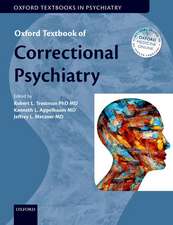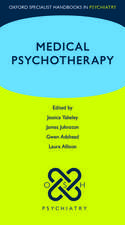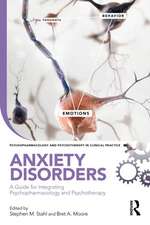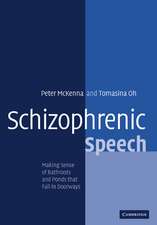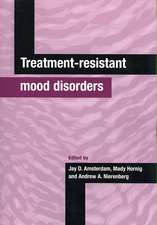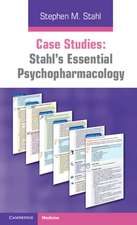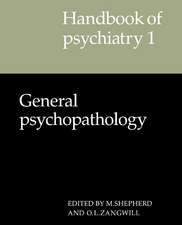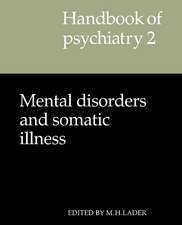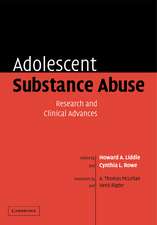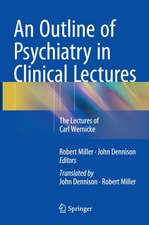Violence in Psychiatry
Editat de Katherine D. Warburton, Stephen M. Stahlen Limba Engleză Hardback – 27 apr 2016
Preț: 643.70 lei
Preț vechi: 677.59 lei
-5% Nou
Puncte Express: 966
Preț estimativ în valută:
123.20€ • 128.12$ • 103.09£
123.20€ • 128.12$ • 103.09£
Carte tipărită la comandă
Livrare economică 14-28 martie
Preluare comenzi: 021 569.72.76
Specificații
ISBN-13: 9781107092198
ISBN-10: 1107092191
Pagini: 354
Ilustrații: 10 b/w illus. 32 colour illus. 55 tables
Dimensiuni: 194 x 253 x 21 mm
Greutate: 0.92 kg
Editura: Cambridge University Press
Colecția Cambridge University Press
Locul publicării:New York, United States
ISBN-10: 1107092191
Pagini: 354
Ilustrații: 10 b/w illus. 32 colour illus. 55 tables
Dimensiuni: 194 x 253 x 21 mm
Greutate: 0.92 kg
Editura: Cambridge University Press
Colecția Cambridge University Press
Locul publicării:New York, United States
Cuprins
List of contributors; Part I. Statement of the Problem: 1. Deinstitutionalization and the rise of violence; 2. The new mission of forensic mental health systems: managing violence as a medical syndrome in an environment that balances treatment and safety; Part II. Assessment: 3. The evolution of violence risk assessment; 4. Assessment of aggression in inpatient settings; 5. Clinical assessment of psychotic and mood disorder symptoms for risk of future violence; 6. Inpatient aggression in community hospitals; 7. Prevalence of physical violence in a forensic psychiatric hospital system during 2011–2013: patient assaults, staff assaults, and repeatedly violent patients; 8. The psychiatrist's duty to protect; Part III. Neurobiology: 9. Deconstructing violence as a medical syndrome: mapping psychotic, impulsive, and predatory subtypes to malfunctioning brain circuits; 10. Aggression, DRD1 polymorphism, and lesion location in penetrating traumatic brain injury; 11. Is impulsive violence an addiction? The habit hypothesis; 12. The neurobiology of psychopathy: recent developments and new directions in research and treatment; 13. The neurobiology of violence; 14. Impulsivity and aggression in schizophrenia: a neural circuitry perspective with implications for treatment; 15. Serotonin and impulsive aggression; Part IV. Guidelines: 16. California State-Hospital Violence Assessment and Treatment (Cal-VAT) guidelines; Part V. Psychopharmacology: 17. Effectiveness of antipsychotic drugs against hostility in patients with schizophrenia in the Clinical Antipsychotic Trials of Intervention Effectiveness (CATIE) study; 18. Clozapine: an effective treatment for seriously violent and psychotic men with antisocial personality disorder in a UK high-security hospital; 19. Augmentation of clozapine with amisulpride: an effective therapeutic strategy for violent treatment-resistant schizophrenia patients in a UK high-security hospital; 20. The psychopharmacology of violence: making sensible decisions; 21. Treating the violent patient with psychosis or impulsivity utilizing antipsychotic polypharmacy and high-dose monotherapy; 22. A rational approach to employing high plasma levels of antipsychotics for violence associated with schizophrenia: case vignettes; 23. Illustrative cases to support Cal-VAT guidelines; Part VI. Treatment Interventions: 24. A new standard of care for forensic mental health: prioritizing forensic intervention; 25. Forensic focused treatment planning: a new standard for forensic mental health systems; 26. Implementing an ecological approach to violence reduction at a forensic psychiatric hospital: approaches and lessons learned; 27. The appropriateness of treating psychopathic disorders; 28. Psychosocial approaches to violence and aggression: contextually anchored and trauma-informed interventions; 29. Co-morbid mental illness and criminalness: implications for housing and treatment; 30. Crime, violence and behavioral health: collaborative community strategies for risk mitigation; 31. New technologies in the management of risk and violence in forensic settings; 32. Risk reduction treatment of psychopathy and applications to mentally disordered offenders; Index.
Descriere
This book focuses on violence from assessment, through underlying neurobiology, to treatment and other recommendations for practice.




